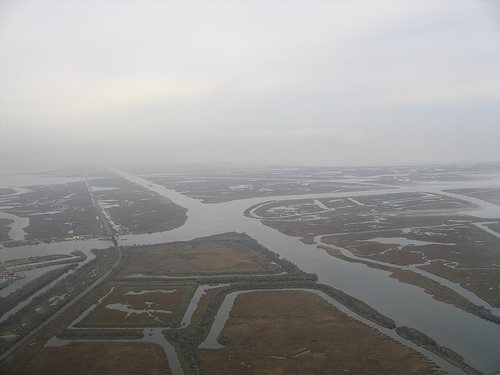
It seems that in the fraying marshes of southern Louisiana, we can’t afford to maintain both shipping and coastal restoration at the same time. Louisiana’s biggest freshwater diversion project — essentially, a set of gates in the Mississippi River levees that let river water to flow over marshlands, depositing much-needed silt — must be closed because it’s affecting ship anchorages nearby. That requires dredging, which would cost $140 million over the next 15 years, and there’s no money available for that:
The West Bay diversion allows 20,000 cubic feet per second of sediment-laced water to flow into the bay, with a goal of creating 10,000 acres of wetlands during its first 20 years of operation. The original plan was to expand it to 50,000 cubic feet per second in a few years to speed the filling process.
A Plaquemines Parish official warned the state board that threatening the diversion sends the wrong message to Congress at a time when Louisiana needs billions of federal dollars for coastal restoration projects.
"If you send out this message that you are considering closing the largest diversion in Louisiana, what you’re looking at is a political disaster in Congress, " said P. J. Hahn, the parish director of coastal zone management.
Obviously, something must be worked out here. The coastline is disappearing at an alarming clip, and there’s no room for error on coastal restoration. If New Orleans and surrounding towns are to remain viable places to live, ambitious projects must get underway immediately. And the ones already in place must stay open.
This snag, however, is huge; if marsh-rebuilding projects must pay their own freight on dredging, their price tags increase sevenfold, from $700 million to $4.9 billion. The real problem here is not deciding who will pay that extra $4 billion, however. It’s the dearth of leadership on this pressing national issue. Currently, these decisions are in the hands of … no one, really. They’re shared between the Army Corps of Engineers and various local, state, and federal agencies and commissions. The Corps, which does the actual work of coastal restoration and dredging, is notorious for its logy decision-making and its deference to shipping interests. The other agencies wrangle amongst themselves and with the Corps over funding and priorities. But there’s no strategic political vision of how all this works, no one who can line everybody up and say "jump." It’s an example of a much bigger challenge: the tendency of our current, over-matched government institutions to fiddle while looming, giant environmental problems burn. Paging President Obama.

